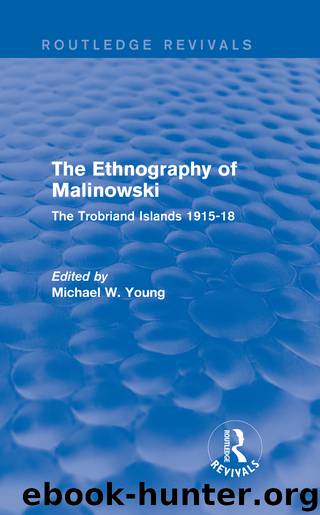The Ethnography of Malinowski by Michael W. Young

Author:Michael W. Young
Language: eng
Format: epub
Publisher: Routledge
6 The significance of urigubu
Let us focus our attention on the group consisting of mother and children and the mother's brother. This group, as we know, forms the real unit of kinship in native theory. The females continue the line, the males represent it in each generation. The males inherit the property, the females through the urigubu gift are made to benefit from a large part of the males' stewardship. The males of several generations work for the females; the females, under the guardianship of their husbands or fathers, lead their sexual and reproductive lives, continuing the lineage of the kindred.
It must be emphatically stated here that it is not the 'clan' which acts as a unit in this complementary division of functions, but definitely the group consisting of brother, sister and her offspring.
The woman's brother then is her natural legal guardian. But he is not enough. He cannot enter in any way into his sister's sexual life, not even indirectly, not even from a great distance. He leases his sister's procreative life as well as her offspring to her husband, as his maternal uncle has leased his mother's reproductive life to his father. Since he has to keep at a distance, physically as well as morally, the marriage must be patrilocal. But with all this the fundamental principles of matrilineal kinship oppose the development of any strong patrilocal or patrilineal family life. In the first place, the matrilineal, that is to the Trobriander the real, kindred of the husband, do not want him to bestow too much attention, privileges and gifts on his children; for a man's possessions and advantages should be kept within his own matrilineal kindred. On the other hand the real, that is matrilineal, kindred of the children, want them back in their community, want them as helpmates and legal successors. The patrilocal household thus is usually broken up, the girls leave the paternal house to marry, the boys return to their maternal uncle. Husband and wife, both old, decrepit and dependent now, remain alone and are still maintained by the wife's family, including her sons.
The urigubu is the endowment by its real head of the matrilineal unit of filiation, and this real head is neither within the household, nor even, as a rule, in the same village. The patrilocal household, on the other hand, which benefits by this endowment has its real head within it. This head also contributes economically to it, but is regarded as a stranger in matters of kinship and his position is legal only in virtue of a series of reciprocities which bind him to his wife, to his wife's brother, and to her offspring.
The urigubu is, therefore, the expression of the real constitution of Trobriand kinship grouping. This grouping is not simple as with us, where it consists of one household, one family, and one unit of filiation. The kinship grouping in the Trobriands embraces on the one hand the unit of filiation - brother, sister and offspring; and on
Download
This site does not store any files on its server. We only index and link to content provided by other sites. Please contact the content providers to delete copyright contents if any and email us, we'll remove relevant links or contents immediately.
Cecilia; Or, Memoirs of an Heiress — Volume 3 by Fanny Burney(30934)
Cecilia; Or, Memoirs of an Heiress — Volume 2 by Fanny Burney(30889)
Fanny Burney by Claire Harman(25784)
We're Going to Need More Wine by Gabrielle Union(18073)
Plagued by Fire by Paul Hendrickson(16637)
Cat's cradle by Kurt Vonnegut(13867)
Bombshells: Glamour Girls of a Lifetime by Sullivan Steve(13108)
All the Missing Girls by Megan Miranda(12748)
Leonardo da Vinci by Walter Isaacson(11903)
4 3 2 1: A Novel by Paul Auster(11049)
Adultolescence by Gabbie Hanna(8145)
The remains of the day by Kazuo Ishiguro(7551)
Note to Self by Connor Franta(7024)
Diary of a Player by Brad Paisley(6866)
Giovanni's Room by James Baldwin(5878)
What Does This Button Do? by Bruce Dickinson(5527)
Recovery by Russell Brand(4564)
Born a Crime by Trevor Noah(4511)
The Kite Runner by Khaled Hosseini(4435)
